I had been weaving for about ten years when I first went to Vermont to study with Norman Kennedy at the Marshfield School of Weaving. While I was going mainly for a four-week weaving class, he had recommended I come a week early for a spinning class. I owned a great wheel (bought from an elderly neighbor who said it was his great-great-great grandmother’s wheel), but could find no one to teach me to use it.
Walking into the barn at Marshfield that first morning was like walking backward into another century. The whole upstairs area was a sea of huge old looms, great wheels, sets of harnesses hanging from the walls, textile equipment I’d never dreamed still existed —
And yes, that first week I did indeed learn to spin on a great wheel – and fell in love with old textile tools. My first project at Marshfield was a blanket: commercial warp, my own handspun weft all dyed by me and my assigned loom was one that had been built in Marshfield and lived there its entire life.
A “barn loom” is a name shortened from “barn frame loom”, and in design is very similar to looms used in Scandinavia, Scotland and many other European countries. Why “barn”? Probably because the basic frame of the loom is similar to the framing of a barn. Or perhaps from the German for a farmhouse (“Bauernhaus”) loom. It could be because of the size (many in this country have an outside “frame” dimension of about 8 ft. by 8 ft. by 8 ft) and the looms were too large for early homes and so were housed in barns. I’ve certainly seen old homes in the Ukraine where the loom was indeed kept in the portion of the building which linked the living quarters of the house to the living quarters of the farm animals!
Most are of mortise and tenon construction, held together with carved or whittled wooden pegs. Warp beams started life as tree trunks and the seats of all our looms are built into the loom frame and are all tilted to some degree. Braking mechanisms differ, from a simple wooden club tied to the back frame, which slots between the wooden pegs or “ratchets” on the warp beam, to bars which fit into the beautifully carved-out back beam, to overhead handles with which the weaver can raise and lower a bar between the ratchets without having to get up from the loom. Most, but not all, are four-shaft, and the harness and batten hang from cross beams laid across the top side rails
I came home with my first barn loom: made of solid maple, very “Scottish” according to Norman, which had only a couple of wooden pieces replaced. Its maker may possibly had not known how to read or write, as the keys to putting it together are all symbols rather than the usual letters or numbers and the brake mechanism is the most primitive — but it’s a beautifully balanced and comfortable loom to use, so he certainly knew how to build functional looms!
ROSEMARY: The loom lived for several years in our garage. On one of his visits here, Norman Kennedy wanted to weave some towels, and taught me to thread and then to weave on that loom: the first loom I ever wove on.
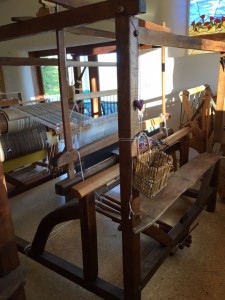
My first Barn Loom Maple/ Vermont. Note the long distance between harness and back beam
When repairs are needed, we’ve been taught by Norman and Craig Evans (Norman’s former apprentice) to use a different wood, so that it’s obvious which parts are not original. When we had some new treadles made to match old ones, we were told by the mill that the originals were made by hand with an adze. Like our Scottish ancestors (who, we’ve been told, were weavers), most repairs are made with materials we have at hand: elbow joints, for instance, make perfect weights, as does the old splitting wedge that anchors one of the brakes!
By 1999, several of our friends in the Bay Area decided they too wanted barn frame looms and great wheels, and so we consulted Norman and Craig (who collected, restored and sold old textile equipment in New England). We flew to Boston, rented a 20-ft. truck from Penske, and started on an epic buying spree.
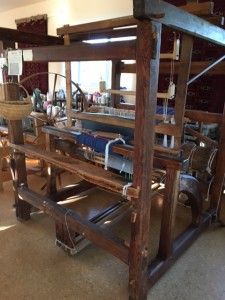
Marshfield Loom
First, the Marshfield loom (which actually stayed in Marshfield) and a wheel from Norman, then down to New Hampshire for a few days with Craig choosing looms and wheels. We brought back four looms (all in near-perfect working order) and nine great wheels that trip: all taken down into piles of boards, carefully labelled, and stacked with old handwoven rag rugs and tarps in between each loom to keep each intact. To fill the truck, we also brought back clock reels, other antique reels and swifts, skarnes (yes, it’s an old Anglo-Saxen term, used by Weaver Rose and other old weavers) and a few old end-feed shuttles.
Craig arranged the great wheels (all antique Shaker wheels in good working order) along the back, with the wheels still on them — tied so that the wheels could still turn freely without touching anything else!
Driving cross country in a truck that big (and full of fragile old tools) was a little scary at times (KAY: the steep pass over the Rockies was a white-knuckled experience! And there was the parking gate I crashed through in Boston, to the great amusement of a couple of watching policemen …) but marvelously fun.
So much fun that two years later we repeated the trip: train to Massachusetts, Penske truck to Vermont and New Hampshire — collecting the Marshfield loom, a small old handmade Italian loom from a quarry worker in Barre, VT, an antique Hungarian flax wheel, and back across the country, this time in a smaller 10-ft. truck.
By this time, we had run out of storage space, and thus the Straw Bale Barn Weaving Studio came into being: a nearly 5,000-sq. ft. 2-story barn-shaped building, with all the looms and wheels upstairs, meeting space and dye kitchen and library downstairs.
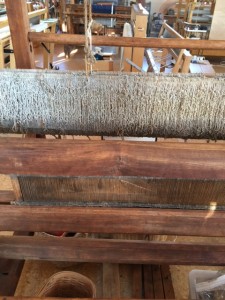
Detail of old string heddles and real reeds in the reed.
We’ve kept the original maple loom, the Marshfield loom, a chestnut loom from Worcester, VT (ROSEMARY: that one’s mine!), and a loom from Kezar Falls, ME (several of our Guild members and my students have woven on that one). All are in working order, although we’ve left the original harnesses, pulleys and hand-tied heddles , as well as an antique reed made by hand of river reeds from the Ukraine, on the chestnut loom for the moment.
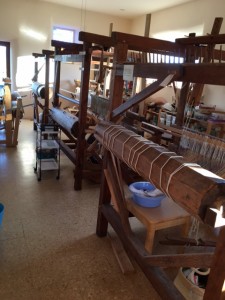
3 in a row,Kezar Falls, Chestnut and Vermont Maple
We have Kay’s original great wheel from Missouri and three or four Shaker great wheels, including one which is signed (ROSEMARY: that one’s mine!). The wheels are used not only for spinning, but also for winding our pirns and quills: just as fast as electric winders, but quieter! The swifts and clock reels too are in use, especially when we have spinning or weaving workshops.
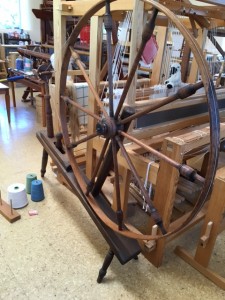
Missouri Great Wheel
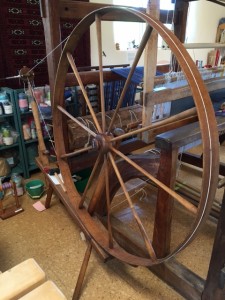
Shaker Wheel
Why the big old looms? Because they weave just as well as modern looms, if not better. Counterbalance looms are excellent for weaving linen, they’re heavy enough for rugs and big enough for traditional blanketing. Repairs to broken threads or threading errors are far easier as there’s tons of room behind the harnesses. Threading is far more comfortable, because we can shift the harness and batten forward and sit on the cloth beam at just the right height while we work. There is still at least 100 years of weaving life left in each of them, if cared for properly.
When we sit on a hand-carved loom bench, handling a beater that has been polished to a satin finish by a couple hundred years of other weavers’ hands, we know that they’re not a part of our weaving life: we’re a part of their living history.
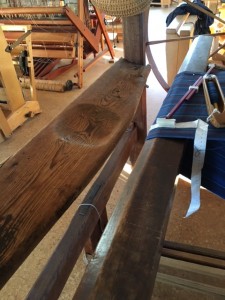
carved seat of Marshfield loom
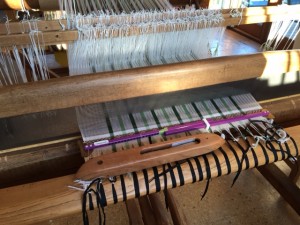
Batten of Vt Loom. Notice the sheen on it. Linen project on loom is at at 40epi
As for their future: we don’t know. Kay has now had both shoulder joints replaced and hopes to weave for at least another 20 years on them; Rosemary is in better shape, and plans to do the same. As we use them for demonstrating during our annual Guild sale, we’ve found carpenters, other woodworkers and metal workers who now help us keep the equipment in good repair, and a good deal of interest in them and in weaving throughout history has been generated. Museums aren’t interested, as the looms and wheels don’t have a local history. Maybe we’ll donate them to our wonderful Central Coast Weavers or eventually find a new owner who weaves and will keep them and the Strawbale Barn Weaving Studio intact and in use.
If anyone is interested in seeing ( or trying) our old equipment, we’re always happy to have visitors.
Email Barnweaver(at) yahoo.com